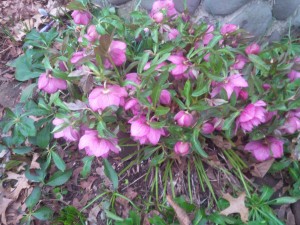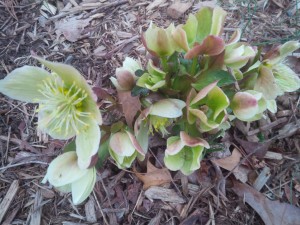

It is one month since the winter solstice and the daylight is making its tentative return. The winter so far in my little corner of the world has been a succession of long gray days with an occasional dusting of snow to remind us of the season. Most days I am able to cast encouraging glances at my slumbering plants, though I haven’t felt a strong urge to get out and tend to them yet.
Today though, I felt the seasonal worm turn when I came back into my front yard and noticed that some of the hellebores had adorned themselves with big fat buds. Now it can snow, rain, sleet and steam, because I have a gardening focus. In the next few days, I’ll look in on all the hellebores to get an idea of when I can reasonably expect open flowers. The lights have gone on again in my garden.
I have acquired lots of different hellebores over the years. My lower back yard is home to a couple of Christmas roses or Helleborus niger, which bear pure white, buttercup-shaped flowers that gradually age to buff pink. These sturdy blooms last on the plants for at least six weeks and look lovely indoors floating in a small bowl of water. The upper backyard also contains an ever increasing collection of stinking hellebore or Helleborus foetidus. “Stinking” is really a misnomer, as the tall, elegant plants really don’t stink much unless you make a point of crushing them. On the plus side, the flowers are an attractive pale green and also cling alluringly to the plants for weeks. The only downside to the stinking variety is that they self-seed with wild abandon, so it pays to keep tabs on them and grub out or give away the extras. If you know someone who has a desperate need to cover a couple of acres quickly, send all your stinking hellebores in his direction.
My favorite hellebores are the double orientalis hybrids, which are known botanically as Helleborus x hybridus. These are varieties that have been bred from a number of different Helleborus species, including Helleborus orientalis, which, according to the admirable reference volume, Hortus, is native to Macedonia, Thrace and Asia Minor.
For all their loveliness, hellebores are poisonous, which is why browsing animals will avoid them. At times in the past, the stinking type has been used medicinally to cure horses from wheezing. Elizabethan herbalist John Gerard also mentions the use of Helleborus foetidus as an emetic for “mad and furious men.” These days, flower lovers can celebrate the fact that there are better cures for “mad and furious men,” leaving breeders free to focus on creating beautiful and useful garden plants.
Back in the dark old days before the current vogue for hellebores, the orientalis types were noted for their downward-facing, somewhat murky colored blooms. The plants were admirable, surviving in partial shade, acting as an evergreen ground cover, playing host to early pollinating insects and rejecting the advances of hungry deer, but they weren’t considered terribly exciting. Then, beginning around the early nineties, breeders in Europe and America got busy and suddenly the world of Helleborus orientalis opened up.
In the United States, the husband and wife team of Ernie and Marietta O’Byrne of Northwest Garden Nursery in Eugene, Oregon, have been hybridizing hellebores since 1992. They are famed for their Winter Jewels series of double orientalis hybrids. A glance at the O’Byrne’s picture gallery, at http://www.northwestgardennursery.com/doubles.html, shows double flowers with arrays of pointed or curved petals in colors ranging from pale cream to nearly black. Many of the varieties are bi-colors with shaded or picotee edges. I am especially fond of the yellow ones, but I wouldn’t turn down any of them.
While the O’Byrne’s created beautiful plants on the West Coast, Dick and Judith Knott Tyler of Pine Knott Farms were hybridizing their own plants in Clarksville, Virginia. Their best known doubles include the Southern Belle Series, which features some gorgeous pink and purple varieties. The Tylers also sell some of the O’Byrne’s hellebores and varieties developed in Europe. If you have not already spent all your money on O’Byrne cultivars, take a look at the Pine Knott gallery page at http://www.pineknotfarms.com/helleborus-x-hybridus/
Visit the Sunshine Farm and Gardens website and you can feast your eyes on even more hellebores, especially luxurious doubles. Breeder and plantsman Barry Glick, who sometimes bills himself as “the king of hellebores,” has planted a large corner of Renick, West Virginia in hellebores and has some of the biggest and boldest around. I especially like his double reds. See his gallery at http://www.sunfarm.com/plantlist/hellebores/hellebore_gallery1.phtml.
If you buy even a few of these stunning beauties and they accommodate happily to your garden, you will probably find yourself engaged in hellebore housekeeping as the years go by. I bought several doubles from Heronswood Nursery a few years ago. Last year and the year before I noticed tiny, new plants popping up around the established growers. Now I am looking forward to seeing at least a few of them bloom in the next six or so weeks. Because they are random-bred, there is no telling what the flowers will look like. However, all the parent plants are lovely, so I am optimistic.
You can buy species hellebores, interspecies hybrids and orientalis hybrids directly from both Sunshine Farms and Pine Knott Gardens. Northwest Garden Nursery is a wholesaler, but you can buy their hellebores from a number of different nurseries, including Pine Knott and Plant Delights Nursery, 9241 Sauls Road, Raleigh, NJ 27603, (919) 772-4794, www.plantdelights.com.
